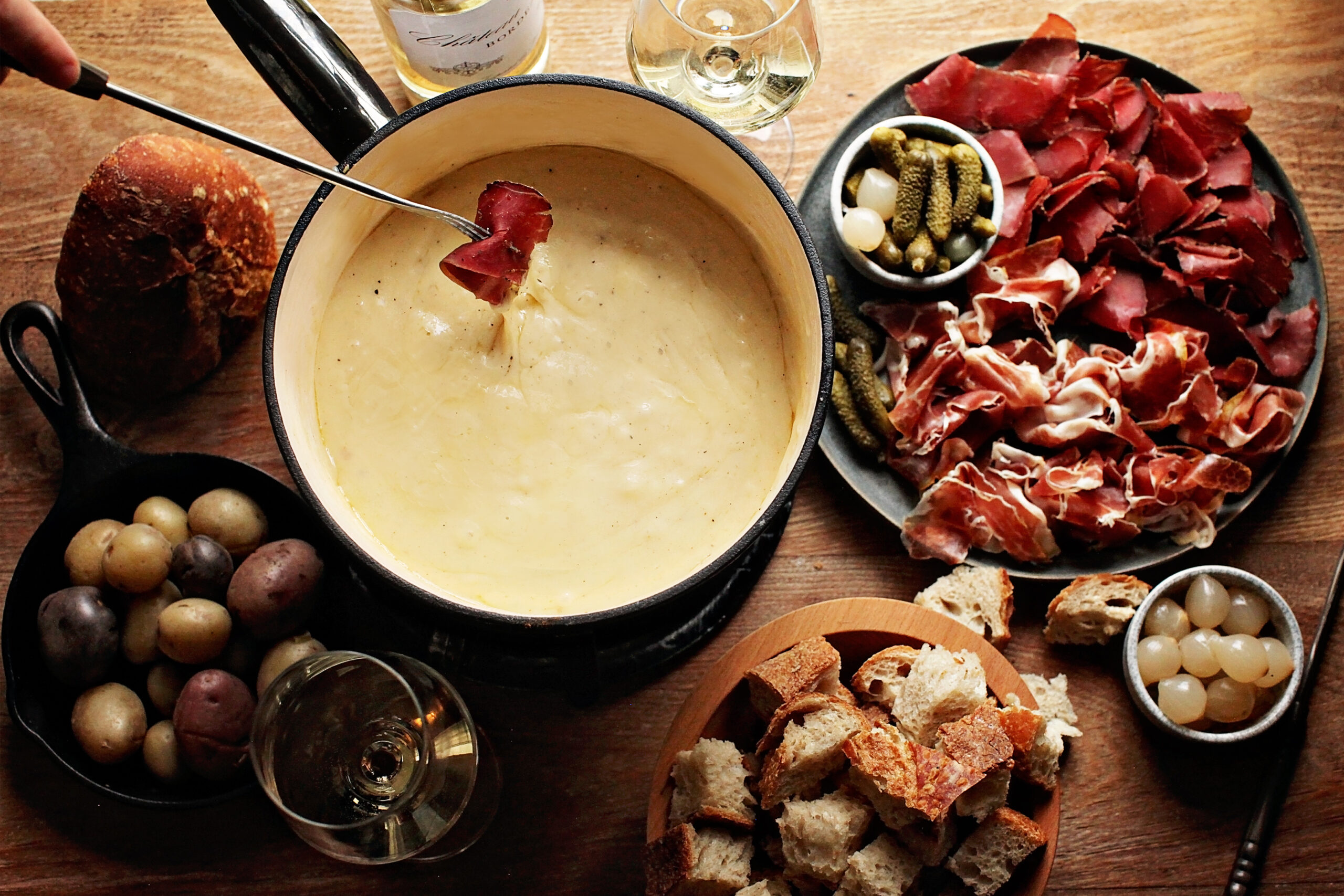
Classic Fondue
Mountains — the Alps, specifically — are the connection between fondue and the cheeses you use to make it. If you’re slopeside in France or Switzerland, you’re not only privy to some of the best powder for skiing, but you’re also in a cheese paradise. No wonder fondue is a favorite après ski meal.
Traditional Swiss fondue isn’t the stuff of kitschy ’70s-themed parties; it’s a beloved culinary staple. Caroline Hostetter, a native of Switzerland, is our authority on Swiss artisanal cheeses — and fondue. Over the last 25 years, her crusade has been to bring artisanal Swiss cheese — some of the finest in the world — to the U.S. market. By teaching, creating awareness, and making hard-to-find cheeses available here, she’s done more to build a U.S. market for artisanal Swiss cheeses than anyone else.
Her recipe for fondue is foolproof if you follow the ratios carefully. It calls for Swiss Gruyère and Vacherin in equal parts but splitting it three ways and adding an Alp cheese is a great idea. Most of us know Gruyère but be wary of the mass-produced kind. Caroline said, “When you offer chefs a taste of real Gruyère from Hoch-Ybrig (a Swiss alpine area famed for skiing and cheese), they say, ‘Wow. That’s not the gruyere that we know.’”
Vacherin Fribourgeois, a pungent Alpine cheese, is the original Swiss fondue cheese. It’s softer than what we traditionally think of as Swiss Alpine cheeses, with a distinct washed rind and strong aroma.
Combine those two — or add one of our Alp cheeses — then follow Caroline’s instructions, and you’ll have a velvety custard with a depth of flavor that will dazzle your guests.
Fondue
By Caroline Hostetter
What to Have on Hand:
Use 6 ounces of cheese per person. The following recipe is for four people.
• 1-2 garlic cloves, peeled
• 1 tsp cornstarch
• 1 pound Gruyère
• 1 pound Vacherin Fribourgeois or any other Adopt an Alp cheese
• 1¾ cups dry white wine (aka half the weight of the cheese)
• 1 Tbsp freshly squeezed lemon juice
• Freshly ground black pepper
• Bread to dunk
Equipment:
Caquelon (a pan, ideally heavy clay or ceramic) & Rechaud (a heater — ideally with adjustable heat like a butane gas burner, or a real fondue heater/stand), wooden spoon, stove to start the cooking process.
What to Do:
• Cut one or two garlic cloves in half and rub the entire inside of the caquelon with the cut sides. This helps prevent the cheese from sticking and adds flavor.
• Pour ¼ cup of wine into a small glass, add the cornstarch, and stir until dissolved. Set aside.
• Add the cheese and remaining wine to the pan.
• Put the pan on the stove over medium heat. Immediately start stirring with a wooden spoon and never stop stirring from this point onward.
• You may increase the heat slightly, but never too high — a fondue requires patience.
• Once the cheese starts melting, reduce the heat to low.
• When all the cheese has melted, add the wine/cornstarch mixture drop by drop.
• Add the lemon juice — don’t forget to keep stirring.
• Add freshly ground black pepper to taste.
• Transfer the pot to the Rechaud (portable heater) and start eating immediately.
What Cheeses to Choose:
The most popular fondue in Switzerland is called Moitié-Moitié (half and half). It consists of half Gruyère and half Vacherin Fribourgeois. The Gruyère adds spice and zing, while the Vacherin makes it creamy and foolproof. An ideal mix is also one-third each of Gruyère, Vacherin Fribourgeois, and an Alp or mountain cheese. As long as the cheese melts well, there are few limits.
My grandmother made a fondue with Fontina and Gorgonzola Dolce, and I know people who use washed-rind Reblochon-style cheese combined with mountain-style cheese, replacing the white wine with beer. What I never use — and suggest others avoid — is Emmentaler. This cheese becomes tough and stringy when heated and doesn’t melt evenly without separating.
What to Dunk In It:
Purists like me use bread and only bread. Baguettes are ideal, and the pieces can simply be torn from the loaf. Alternatively, choose any firm bread with a good crust and cut it into bite-sized cubes before cooking the fondue, allowing them to dry slightly. Other dunking options include boiled potatoes, raw crunchy vegetables like broccoli, carrots, peppers, or fruits like apples, pears, grapes:
What to Drink with It:
It’s best to stay classic: serve a dry white wine for those who drink alcohol, or hot black tea for those who don’t. About halfway through the fondue, pour a small glass of kirsch for each person to enjoy like a shot — it’s said to aid digestion.
Enjoy!
